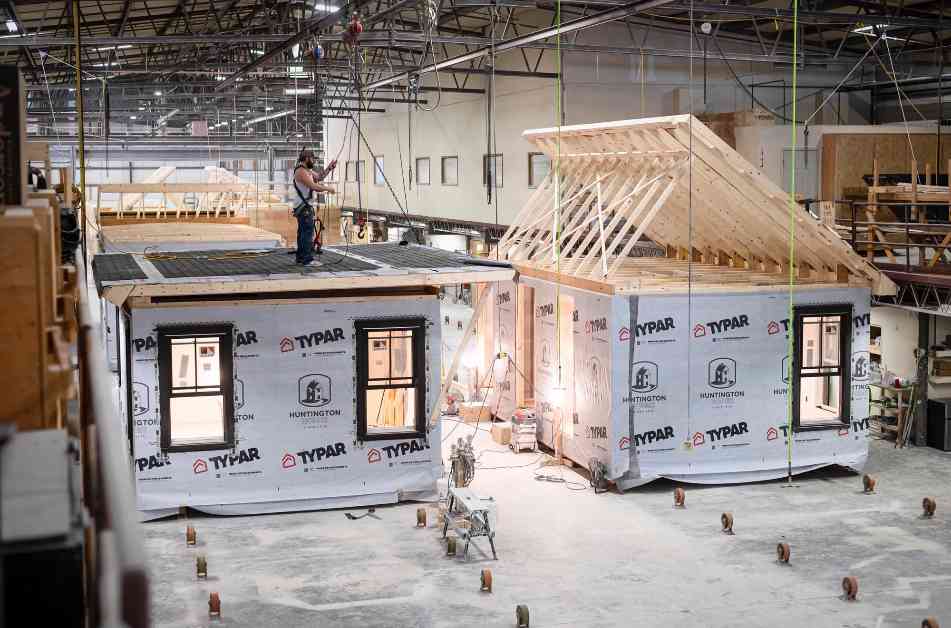In a cavernous factory down a quiet road in East Montpelier, Vermont, homes are built piece by piece on an assembly line, revolutionizing the traditional construction process. As you step inside the 100,000-square-foot shop, the air buzzes with activity, and the rhythmic hum of machinery fills the space. Huntington Homes co-owner Jason Webster leads the way, describing the intricate process as homes transform from simple “Lego blocks” into fully-fledged residences.
Each house begins its journey in one corner of the factory, gradually taking shape as floors, walls, and ceilings are assembled along the production line. Unlike conventional construction methods that require coordinating multiple subcontractors, here, electricians, plumbers, and roofers work seamlessly under one roof, streamlining the building process and drastically reducing construction time.
Webster proudly shares, “We can build a whole house in 12 eight-hour shifts — so, 96 hours.” The efficiency of this approach allows Huntington Homes to complete a house in a matter of days, a stark contrast to the typical months-long timeline of traditional building methods. Once the “Lego blocks” are meticulously crafted, they are loaded onto trucks, shipped to their destination, and effortlessly pieced together by a crane, resulting in a finished product that rivals traditionally built homes.
Vermont’s Housing Shortage Dilemma
Despite the innovative strides made by Huntington Homes, Vermont continues to grapple with a severe housing shortage, as evidenced by the construction of just over 2,000 homes in the state last year. This figure falls significantly short of the estimated annual requirement to sustain a healthy economy, prompting a pressing question among housing experts: should Vermont embrace assembly line construction to address the housing crisis?
The Potential of Mass Production
Delving into a recent state-commissioned report that explores the growth of Vermont’s off-site construction industry, experts examine the potential of modular construction as a solution. Huntington Homes stands out as a major player in the modular building landscape within Vermont, alongside smaller outfits like VerMod and New Frameworks, each contributing unique perspectives to the off-site construction sector.
The concept of mass-producing homes in factories offers a myriad of benefits, as highlighted by housing researcher Jeff Lubell. Beyond enabling year-round construction in Vermont’s harsh winters, this approach presents opportunities for a diverse workforce and cost savings through economies of scale. By standardizing home designs and leveraging bulk material purchases, modular builders can offer more affordable housing options to buyers, a crucial consideration amidst rising housing costs.
Challenges and Opportunities Ahead
While the promise of assembly line construction is enticing, it comes with its own set of challenges. The upfront investment required to establish manufacturing facilities poses a financial risk during economic downturns, as evidenced by the closure of the Fair Haven plant in 2011. Despite these obstacles, the demand for homes in Vermont remains high, signaling a need for innovative solutions to expedite home production.
As Vermont grapples with the delicate balance between risk and reward in bolstering off-site construction, the state’s commitment to addressing the housing crisis remains steadfast. By exploring strategic initiatives such as bulk purchase agreements and factory revitalization efforts, Vermont aims to pave the way for a more efficient and sustainable housing future. In the words of Housing Commissioner Alex Farrell, the time is ripe for Vermont to embrace change and accelerate home construction to meet the growing needs of its residents.
In conclusion, the journey towards embracing assembly line construction represents a pivotal moment in Vermont’s housing landscape, offering a glimpse into a future where efficiency, affordability, and innovation converge to address the pressing housing shortage. As the state navigates the complexities of modernizing its construction industry, one thing remains clear: the quest for accessible, quality housing for all Vermonters is a shared goal worth pursuing, one modular home at a time.









